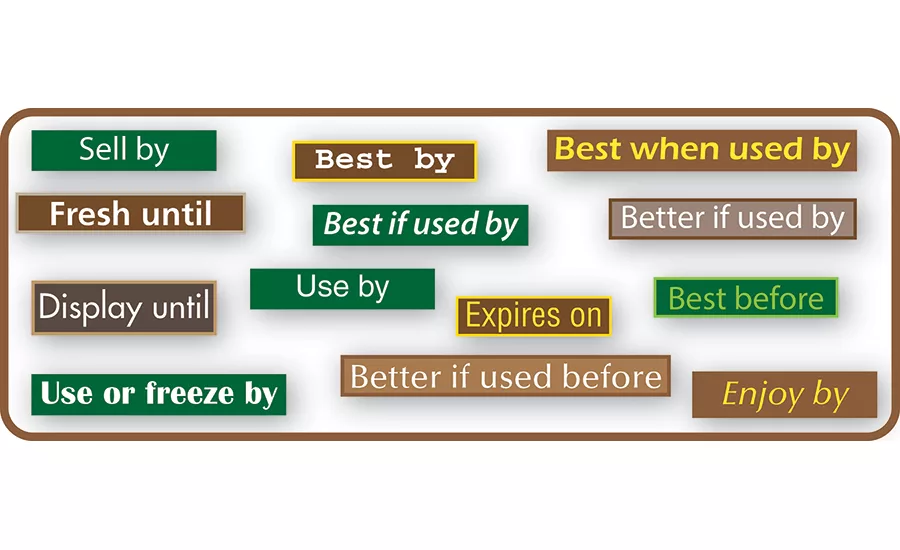Manufacturing News
Much food waste comes from misinterpretation on product date labels

These date labels are the most often seen at grocery stores—though there are many other variations—making buying choices confusing. Except for “best before” (which has become a UK standard), U.S. agencies recommend using the green-with-white-text date labels.
Image content provided by U.S. GAO
Imagine the frustration a consumer feels after spending two minutes to locate a “best by” date on a food product—only to find instead a “display until” or “harvested on” date in seven-point black text on a dark-green background. It’s no wonder there’s cursing under one’s breath. Finding, checking and understanding date codes on products can take longer than locating the products themselves.
In September, FE looked at food loss and waste in the supply chain, following up on a May 2018 news story. In this go-round, FE finds that the U.S. Government Accountability Office reports a great deal of food waste comes from consumers’ misinterpretation of product date labels. It’s no wonder. The proliferation of various forms of “best by” dates (or simply date labels) is enough to cause consumers not to buy a product with a short “sell by” date, leaving it to be junked at the store—or tossed prematurely at home—when the product is still perfectly fine.
The GAO report, “Date Labels on Packaged Foods” (GAO-19-407), finds some progress with federal agencies working together to specify fewer but more definitive date labels. However, it also blames federal agencies for not working with state, local and municipal authorities to help address customer confusion about date labels on packaged foods.
The issue is compounded at the state and local level because there is no consistency from state to state or among municipalities in date labeling requirements. While some states specify a date label on one food, other states have different rules, which may or may not include the same foods—or none at all. For example, GAO looked specifically at eggs, dairy and shellfish and found Pennsylvania requiring labels on milk only, Texas on shellfish only, Georgia on all three—while 11 states do not require date codes in all three categories.
The crux of the situation is that the FDA and the USDA, while having jurisdiction on nutrition and allergen labels, have no say in date codes—except FDA on infant formula. Though FDA exercises its general authority to assist state and local governments with food safety efforts through its State Cooperative program, it has no power concerning date labels.
It’s just as bad at state and local levels. Where no state or local regulations are in place regarding date labeling, manufacturers may decide which of their packaged food products display a date label and what wording to use. Estimates on the number of different date labels currently in use across industry vary.
In an effort to make some order out of the chaos, the Food Marketing Institute (FMI) and Grocery Manufacturers Association (GMA) announced a voluntary initiative in 2017 to encourage manufacturers and retailers to adopt either of two introductory phrases for date labels on packaged foods:
- A “best if used by” label as an indication of product quality
- “Use by” for certain perishable products that may be more susceptible to degradation of quality or potential food safety concerns
In December 2018, FMI and GMA reported that in a consumer survey on these date labels, 88% said these two date label phrases were clear to them, and 85% said they were helpful.
Problems also exist internationally, but the Consumer Goods Forum and the United Nations have teamed up to decrease food loss and waste. To do this the Consumer Goods Forum has called for standardized date labels. Some countries have already begun the standardization journey. For example, the UK issued guidance on date labels where all packaged foods must display either a “best before” or “use by” date on the packaging or label. Canada requires that prepackaged products with a durable lifetime shorter than 90 days must use a “best before” (or “meilleur avant” in French) date label.
Based on surveys and other data, both USDA and FDA are taking steps to clarify date label confusion. USDA’s FSIS has suggested using “best if used by” and adding “freeze by” labels. It also suggests a “sell by” date for retail stores. While the FDA requires a “use by” date on infant formula, it has been suggesting using “best if used by” date labeling for its constituents.
FDA recommends consumers download USDA’s FoodKeeper app, which provides help with hundreds of foods in terms of safekeeping. It also links with calendars to remind users when food should be tossed.
For more information, download the GAO report (GAO-19-407) at www.gao.gov.
Looking for a reprint of this article?
From high-res PDFs to custom plaques, order your copy today!







